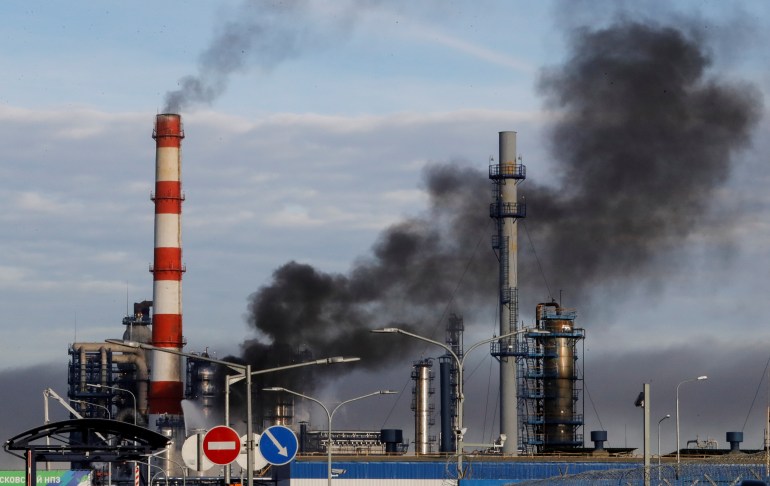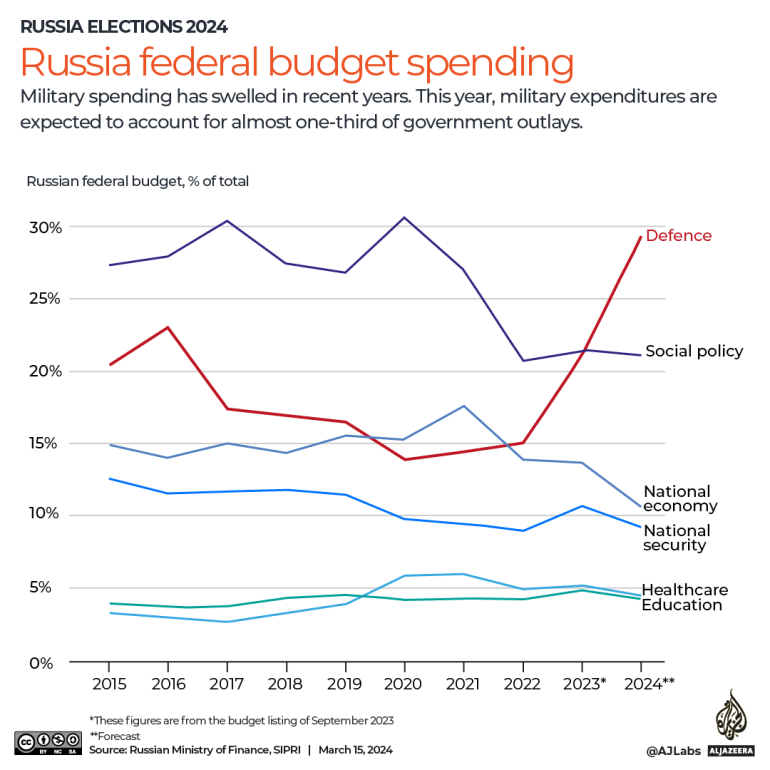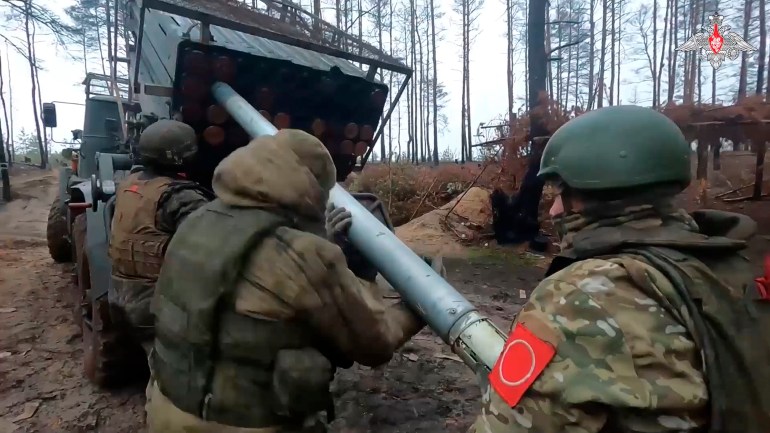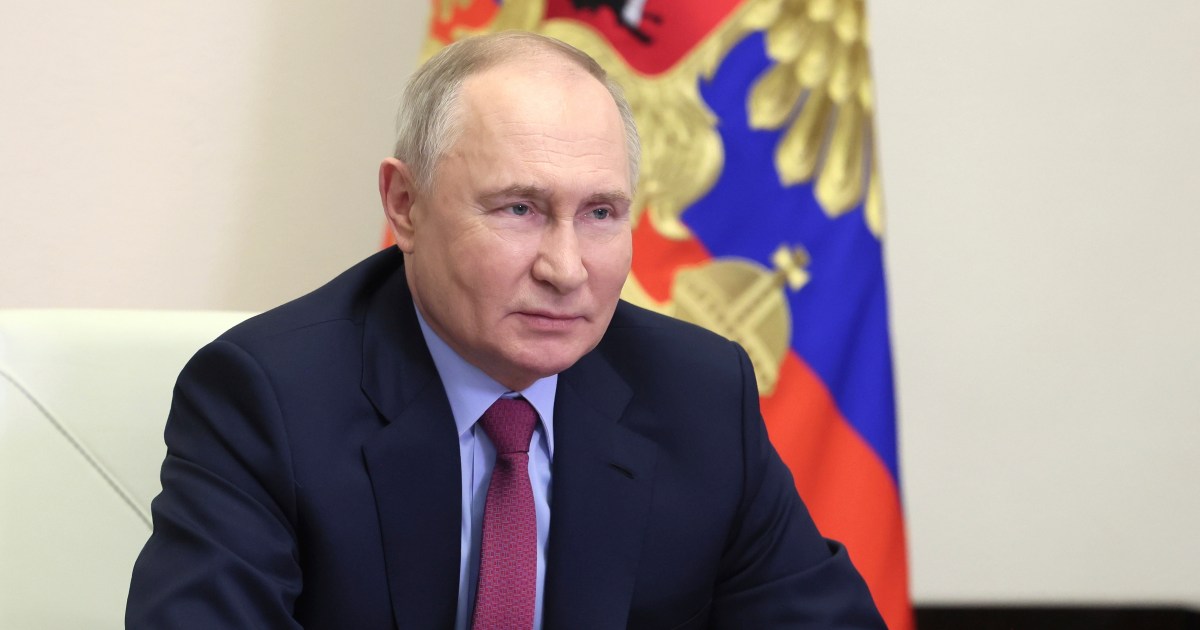Russia’s success in evading Western sanctions has helped its economy outperform expectations ahead of Vladimir Putin’s all but certain re-election on Sunday.
Ever since Russia’s invasion of Ukraine in February 2022, the Russian economy has consistently defied the dire predictions of critics.
That resilience appears to be holding firm as Russians head to the polls between Friday and Sunday for a presidential election that is set to ensure Putin’s rule until at least 2030.
At the start of the war, the International Monetary Fund expected a prolonged recession, forecasting the economy to contract by 8.5 percent in 2022 and 2.3 percent in 2023. While Russia’s economy did shrink in 2022, the contraction was just 1.2 percent, according to government figures. Last year, the economy officially grew 3.6 percent.
According to Castellum.AI, a global risk platform, Russia has been slapped with 16,587 sanctions since the start of the war – the majority of them against individuals. Some $300bn of Russian assets have been frozen.
Other restrictions apply to international debt markets and industrial imports. The most consequential sanctions limit natural gas exports and place a cap on Russian oil prices.
“I can’t say sanctions have had a big impact on me,” Nikolai Zlatarev, a Moscow resident who works in education, told Al Jazeera. “My weekly shop is a little more expensive and I buy more Russian brands. But I doubt that drinking Dobry Cola instead of Coca-Cola will change the election.”
Owing to high oil prices and elevated military spending, Russia has managed to mitigate much of the impact of sanctions. But the costs of prolonged conflict, and the possibility of yet more sanctions, look set to weaken output over the medium term.
“Extra spending unleashed by war can boost economic activity. But it also represents a redistribution of income away from state services towards the army,” Konstantin Sonin, a political economist at the University of Chicago, told Al Jazeera.
Military spending has swelled in recent years, rising from 3.9 percent of the gross domestic product in 2023 to about 6 percent in 2023 – the highest it has been since the collapse of the Soviet Union. This year, military expenditure is expected to account for almost one-third of government outlays.
Significant investment in military hard and software, together with welfare handouts for the families of soldiers killed in the war, have supported wage growth.
Meanwhile, Russia’s massive energy sector has kept money flowing into state coffers, while local companies have made substantial efforts to substitute Western imports.
“Import substitution always happens with trade restrictions,” Sonin said.
“Most critically, Russia has continued to sell plenty of fossil fuels. It’s true that oil and gas exports have fallen because of sanctions, but elevated prices have kept overall revenues high,” he said.
Sonin added that “it’s important to recall the size of Russia’s fossil fuels sector. Domestically, oil accounts for roughly one-third of tax receipts and half of all export revenue”.
The Kyiv School of Economics estimates that Moscow made $178bn from oil sales last year and that revenues could rise to $200bn in 2024 – not far off the $218bn earned in 2022.
In May 2022, the European Union agreed to cut 90 percent of its oil imports from Russia. Then, in December 2022, Australia and G7 members announced a price cap on Russian crude oil – known as Urals crude – aiming to squeeze Moscow’s finances even further.
Under the rules, non-G7 oil traders can only use Western ships and finance or insurance services provided they pay $60 per barrel, or less – well below the market-rate.

But Russia has proved adept at countering these measures, according to Switzerland-based energy trader Mohammed Yagoub.
“Russia has built up a large ‘shadow fleet’, which are tankers with opaque ownership and no Western ties in terms of finance or insurance. In addition, Russia has found plenty of non-Western oil buyers at discount prices, China and India most notably,” Yagoub told Al Jazeera.
“Last month, the majority of Russian Urals were sold above $60. But, Western countries have been clamping down,” Yagoub added, pointing to a reported information request from the US Treasury to shipping companies suspected of violating the cap.
“Over the past year, the Kremlin’s been lucky. Western countries don’t want to snuff out Russian oil altogether, because a supply crunch would trigger global inflation. So, they’ve just chugged along much as they were before the war.”

Russia has also found ways to skirt import restrictions by sourcing goods from countries acting as intermediaries for Western goods. For instance, Serbia’s exports of phones to Russia rose from $8,518 in 2021 to $37m in 2022.
Some observers dispute the suggestion that the pressure campaign against Moscow has backfired.
“Sanctions are working,” Liam Peach, a senior emerging markets economist at Capital Economics, told Al Jazeera.
“It’s reasonable to assume that longer journey times for tankers [previously travelling to EU countries], together with high insurance premiums, have added roughly $30 a barrel to the cost of oil sales.”
“On top of elevated military spending, lower oil revenues will see the deficit widen to 3 percent this year, from 1.5 percent in 2023,” Peach said. “That will require scaling back on other areas of state spending, like healthcare and education, which will slow growth over time.”
Peach also pointed out that falling exports have led to sharp currency depreciations, making imports more expensive. To put a lid on rising prices, the Bank of Russia hiked interest rates by 8.5 percent in 2023, which will also slow economic activity.

Elsewhere, Putin is grappling with a labour shortage aggravated by his military mobilisation efforts. The UK Ministry of Defence has estimated that more than 350,000 Russians have been killed or injured in the war.
Re: Russia, an analysis and policy network, has estimated that close to one million Russians, roughly 1 percent of the workforce, have emigrated since the invasion.
These losses have compounded looming demographic challenges as Russia’s birthrate was already below the replacement level of 2.1 before the war.

“The upshot is that economic growth will become more constrained on the supply side, and GDP will likely fall from around 3 percent this year to 1.5 percent by the end of the decade. National output will be particularly weak during periods of low oil prices,” Peach said.
“But I don’t think a gradual economic slowdown will be a big threat to Putin,” Peach added. “Russia has experienced its fair share of crises in recent decades. As long as inflation and the rouble remain broadly stable, low growth is unlikely to topple the government.”
For Zlatarev in Moscow, conditions remain far better than the widely remembered economic crises of the 1990s.
“Compared to then, things are OK. Even if the costs of this conflict are high, Putin is still viewed as a net positive,” he said. “Most people I know have said they’ll vote for him.”

